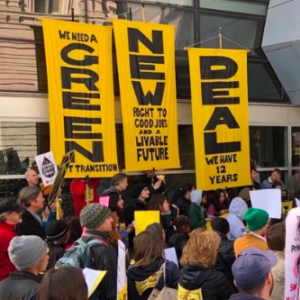Without intending it, and quite apart from the U.S. Senate’s stance, trumpet calls for a Green New Deal (GND) perversely heralds a retreat from combating climate change.
This odd result derives from efforts to crimp shale-derived U.S. natural gas production. Enemies of fossil fuels would cut shale production right down to zero, an absolutist aim reflecting their belief that all hydrocarbons have an equally malign climate effect.
Like anti-machine Luddites a few centuries ago, this outlook ignores the upside, i.e., the climate benefit gained from displacing a comparatively dirty fuel with a comparatively clean one. Natural gas combusts much more efficiently than coal; shifting to gas for power generation has enabled the United States, by 2017, to cut greenhouse emissions. Natural gas signals over time a possible global phaseout of carbon-heavy coal.
By categorizing all fossil fuels as equally harmful, GND enthusiasts posit a best case/carbon-free outcome as the only permissible solution to relentless global demand for electricity. Yet a big gap still divides what renewables can now do, and what we want them to do, even with heavy subsidies.
Even if consensus eventually settles on long-term elimination of hydrocarbons, something in a shorter time frame needs happen to slow down and reverse the now preponderant coal use by the world’s mega-economies. Beyond that, the GND collides with the following energy realities:
An enormous increase in committed global power generation capacity.
Renewables (chiefly wind and solar, but hydro also) on their own cannot deliver the intended power. Apart from coal, only natural gas can provide the gigawatts within the time frame to which governments have staked their legitimacy.
With 40 percent of total world population between them (and over half the total global greenhouse gas emissions), China and India compel special attention.
Natural gas doesn’t eliminate greenhouse emissions. But it buys time in the climate change countdown — time to overcome persistent renewable energy obstacles such as devising new battery storage systems, coping with windless conditions, and offsetting low rainfall and variable sunshine.
To be clear, environmentalists in and out of Congress have found the right cause. This winter, the U.S. meteorological service confirmed the gravity and pace of climate change: 2018 ended as the planet’s fourth hottest recorded year.
Here’s a suggestion: House Democrats should contemplate embracing the “bridge fuel” potential of natural gas. It’s not an either/or proposition. The major energy corporations already have a big place for renewables in their investment portfolio.
Understandably, those hating hydrocarbons dislike the irony of an irrefutable causal link between cheap natural gas (increasingly derived from shale) and the reversal of hitherto steadily rising greenhouse gas emissions in some world regions. In our own country, natural gas has now dethroned King Coal — whose once-dominant position in North American power markets has now slipped to a 40-year low.
Unloved, even loathed, by the environmental left, natural gas has another role — as LNG exports giving Asia’s enormous economies respite from the pollution and planet-altering impact of coal. And these new markets offer improved terms of trade for the United States.
It seems odd to use one fossil fuel to abate the effect of others. Although the evidence stands unchallenged, there’s very little “give” from climate activists who see no good in any fossil energy, anytime. Perhaps it’s easier to trumpet virtuous intention, but not actual results — an absolutist cop out in which perfection becomes the Enemy of the Good.
Maybe it’s better to think of natural gas as a vaccine inoculating rapidly growing economies from an even higher carbon concentration. By displacing dirtier fuels, natural gas can help slow the rise in global temperatures. It can buy time in which renewable fuels become scalable and carbon-capture technologies more affordable.
Ultimately, yes, the planet must learn to burn less fossil fuel. Yet for the time being, the right fossil fuel can deliver the megawattage that enormous developing economies demand — and can do so with much less pollution and climate stress.

